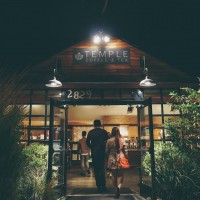Coffee’s third wave: First Folgers, then Peet’s, now Temple and others
 NORTHERN CALIFORNIA INGENUITY HAS helped give rise to America’s coffee culture, now a booming $30-billion-a-year industry. More than 60 percent of Americans say they drink coffee, totaling 400 million cups per day. Coffeehouses and cafes now surpass fast-food restaurants in their growth.
NORTHERN CALIFORNIA INGENUITY HAS helped give rise to America’s coffee culture, now a booming $30-billion-a-year industry. More than 60 percent of Americans say they drink coffee, totaling 400 million cups per day. Coffeehouses and cafes now surpass fast-food restaurants in their growth.
The first wave of coffee began in the Gold Rush-era when Folgers Coffee was founded. James A. Folger introduced San Francisco and the gold miners to coffee made from Latin American beans. Folgers’ distinctive red-brick building near the waterfront, which served as a factory and warehouse, is listed on the National Register of Historic Places.
In the television era, Mrs. Olson (the Folgers’ “coffee lady”), Juan Valdez (the “coffee grower”) and Joe DiMaggio (“Mr. Coffee”) helped sell the mass-marketed blends and coffeemakers.
The second wave of coffee began in the ‘60s when Alfred Peet opened a small coffee store in Berkeley called Peet’s Coffee & Tea. His style of coffee was new: small batches, fresh beans, superior quality and a dark roast. Peet’s coffee venture was akin to the locavore food movement, led by Alice Waters of Chez Panisse.
The artisan coffee movement gained momentum with Starbucks’ founding in 1971 as a Seattle coffee bean roaster and retailer. On average, two Starbucks have opened every day since 1987, thanks to aggressive expansion by chief executive Howard Schultz. Starbucks helped introduce the words latte, French roast, and cappuccino into our daily lives.
Now we’re experiencing coffee’s “third wave,” where coffee is considered an artisan food, like boutique wines, craft beer, aged cheeses or chocolates— not a commodity. “The third wave is a reaction to those who wanted to automate and homogenize specialty coffee,” wrote Trish Rothgeb of Wrecking Ball Coffee Roasters in a 2002 newsletter. She is widely credited with coining the term.
Farm to Cup
Most third wave coffee is served in independently owned and operated coffeehouses with few chains.
Examples include independents, as well as Blue Bottle Coffee in San Francisco, and Temple
Coffee and Old Soul in Sacramento. Temple opened in 2005, and its “farm to cup” sourcing program incorporates three “pillars of sustainability”: social, economical and environmental.
Temple workers travel multiple times a year to source the finest craft coffees and build sustainable, direct relationships with farms, often paying premiums well above fair-trade price. Eton Tsuno, director of coffee at Temple, tastes hundreds of coffees while visiting the farms, searching for the perfect bean. The result is award-winning, farm-to-cup coffees.
Temple and Old Soul recently were named among the nation’s 30 best coffees by acclaimed Coffee Review, enhancing Sacramento’s reputation as a coffee town over rival San Francisco.
Third wave coffee aspires to culinary appreciation at all stages of production, from coffee bean growing, harvesting, roasting and preparation.
Though seemingly laid back, the new generation of baristas typically are true competitors who work in stores in the same neighborhoods as Starbucks. They fine-tune the temperature gauge of the espresso machine or create imaginative latte art to create the perfect cup.
“The third wave insists you have to focus on the production end, and you have to see the relationship between the producer and the consumer ends of the coffee chain,” writes Michaele Weissman in God in a Cup. “They are not the first guys to realize farmers matter—far from it. But they are the first to travel constantly and communicate readily with farmers in remote locations.
“Guys who compare great coffee to great wine are able to detect hundreds of flavors and aromas in a coffee from a small farm in Guatemala, just as great wine masters discern countless subtleties in an aged Burgundy.”
(Photo: Cole Cuchna; Temple Coffee)
